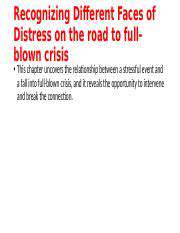Recognizing Distress Signals: A Comprehensive Guide for Caregivers
Common Signs of Distress to Look For
Physical Symptoms of Distress
Caregivers should be vigilant in observing any physical changes that may indicate a person is in distress. These may include changes in appetite, sleep disturbances, or unexplained fatigue. For example, a significant drop in food intake can be a red flag that something is wrong emotionally or psychologically.
Other physical manifestations may include symptoms such as increased heart rate, sweating, or even shaking. Such symptoms can often be triggers for caregivers to dive deeper into understanding the person's emotional state and well-being.
Behavioral Changes Indicating Distress
Behavioral indicators can often be more subtle but just as telling. A sudden withdrawal from social interactions or activities that a person usually enjoys can signal distress. Caregivers should take note of any drastic changes in engagement levels, as isolation can exacerbate feelings of anxiety or sadness.
Additionally, anger outbursts, irritability, or increased frustration can also indicate that someone is struggling. Watching for these signs is crucial, as it may help caregivers to initiate supportive conversations and interventions early on.
Emotional Signals to Monitor
Emotional distress can manifest in various ways, and caregivers must be aware of the signs. Look for frequent crying, sadness, or expressions of hopelessness. These emotional signals may indicate that the individual is feeling overwhelmed and may need additional support or professional help.
Moreover, feelings of worthlessness or excessive guilt can often accompany mental distress. Caregivers should take these feelings seriously and look for ways to provide reassurance and emotional support, encouraging open communication and validation.
Communication Cues that Suggest Distress
The way individuals communicate can provide essential insights into their emotional states. If a person begins to use negative language frequently or expresses thoughts of inadequacy or despair, it’s vital for caregivers to recognize these cues. Such communication may serve as a cry for help that should not be overlooked.
Also, a decline in interest in conversations or a general reluctance to communicate can indicate distress. Caregivers should strive to create a safe environment for dialogue, reinforcing that it’s okay to express feelings and seek help when needed. This will help foster trust and encourage individuals to share their thoughts more openly.
The Importance of Active Listening
The Role of Active Listening in Caregiving
Active listening is a crucial skill for caregivers, as it fosters trust and open communication between the caregiver and the individual in their care. By fully concentrating on what the person is saying, caregivers can better understand their needs, feelings, and concerns.
One of the key components of active listening is the ability to provide feedback. This can be through verbal affirmations or nonverbal cues like nodding. By acknowledging what the person is expressing, caregivers can create a supportive environment that encourages individuals to share their distress signals more freely.
Additionally, active listening involves withholding judgment. Caregivers must approach conversations with empathy and an open mind, allowing the individual to express themselves without fear of criticism. This validation can significantly enhance the individual's sense of security.
Moreover, asking open-ended questions is an essential part of active listening. Caregivers can encourage the individual to elaborate on their feelings, which can reveal underlying distress signals that may not be immediately apparent.
Ultimately, active listening not only helps identify distress signals but also strengthens the bond between caregivers and those they care for, making it an invaluable technique in effective caregiving.
Techniques for Enhancing Active Listening Skills
Improving active listening skills requires practice and dedication. Caregivers can start by minimizing distractions when engaging in a conversation. This can involve finding a quiet space or setting aside electronic devices, allowing for an undisturbed exchange.
Another effective technique is to mirror the emotions displayed by the individual. By reflecting their feelings through body language and tone, caregivers can demonstrate that they are engaged and concerned about the individual's well-being.
Summarizing what the individual has said can also reinforce active listening. Caregivers can paraphrase key points or repeat back critical information to ensure understanding and show that they are genuinely engaged in the conversation.
Practicing patience is vital in enhancing active listening skills. Caregivers should give the individual ample time to express their thoughts without interrupting, allowing for a more meaningful dialogue.
Finally, caregivers can seek feedback on their listening skills from the individuals they care for. This openness to critique can provide insights into how effectively they are listening and what areas might need improvement, further honing their ability to identify distress signals.
Creating a Safe Space for Communication
Understanding the Importance of Open Communication
Open communication is crucial for building trust between caregivers and those in their care. When individuals feel safe to express their thoughts and feelings, it becomes easier to identify distress signals. This openness encourages them to share experiences they might otherwise keep hidden.
Establishing an environment where conversations can flourish leads to better emotional and psychological well-being. In such an atmosphere, caregivers can learn about the subtle signs of distress that may not be immediately obvious.
Encouraging dialogue not only aids in recognizing distress signals but may also help in developing coping strategies. It allows caregivers to offer appropriate support and interventions, which can significantly impact the individual’s ability to manage their distress.
Closed or negative communication environments can contribute to feelings of isolation and despair. In establishing open channels for communication, caregivers can help mitigate these feelings by showing genuine interest and concern.
Ultimately, prioritizing open communication cultivates a partnership where caregivers and those they care for can share responsibilities and actively participate in addressing distress signals together.
Techniques for Creating a Supportive Environment
Creating a supportive environment begins with active listening. Caregivers should practice empathy and attentiveness when interacting with individuals. By validating their feelings and experiences, caregivers help foster a sense of safety and understanding.
Establishing regular check-ins is another effective technique. By scheduling consistent moments of conversation, caregivers can create routine opportunities for individuals to express any concerns, thoughts, or feelings they may have. This invites communication and makes it easier to identify distress signals over time.
Utilizing non-verbal communication cues is equally important. Facial expressions, body language, and tone of voice can convey messages that words may not fully express. Caregivers should be attentive to these signals as they might indicate underlying distress.
Maintaining privacy can also enhance the feeling of safety during discussions. Ensuring that conversations remain confidential encourages individuals to share openly without fear of judgment or repercussions.
Lastly, employing a variety of communication techniques—such as journaling, art, or music—can create additional avenues for expression. Different individuals may respond better to different modes of communication, and these creative methods can often reveal feelings that might not surface in traditional conversations.
Tailoring Your Response

Understanding the Individual Needs
Every individual experiences distress in different ways, and it is crucial for caregivers to recognize these unique signals. By understanding the individual's background and context, caregivers can better interpret their distress signals. This includes considering factors such as mental health history, cultural background, and past experiences.
Encouraging open communication with the individual can also provide insights into their specific needs. Listening attentively and validating their feelings may help in understanding their reactions and establishing trust.
Caregivers should be aware that some individuals may exhibit non-verbal signals of distress, such as changes in body language or facial expressions. Recognizing these signals early can allow caregivers to respond more effectively.
Involving the individual in their care plan can empower them to express their preferences, thereby reducing distress. When people feel seen and heard, it can significantly ease their anxiety.
Implementing Effective Communication Strategies
Effective communication is key when responding to distress signals. Caregivers should aim to create a safe and welcoming environment for dialogue. This includes using a calming tone and clear language that the individual can understand.
Active listening is also an important strategy; caregivers should give their full attention and acknowledge the individual's feelings. Reflecting back what the individual has said can demonstrate empathy and encourage further sharing.
Non-verbal communication, such as maintaining eye contact or using gentle gestures, can also help convey support. Caregivers should remain mindful of their own body language, as it can influence the individual’s comfort level.
In some cases, employing written communication or visual aids can assist individuals who struggle with verbal expression. This can facilitate a more comprehensive understanding of their needs and concerns.
Assessing the Environmental Factors
The environment can play a significant role in an individual's distress response. Caregivers need to assess the surroundings to identify any stressors that may contribute to the individual’s anxiety. Common environmental factors include noise levels, lighting, and overall ambiance.
Reducing distractions and creating a calming space can enhance the individual's ability to relax. For instance, soft lighting and comfortable seating can help in fostering a sense of safety.
Implementing routine and consistency can also mitigate feelings of distress. Individuals often find solace in predictability, so maintaining regular schedules can contribute to their overall well-being.
Lastly, involving the individual in the evaluation of their environment can give them a sense of control. This participatory approach not only values their input but can also lead to a more effective distress management strategy.
Developing Coping Mechanisms
To support individuals experiencing distress, caregivers should assist in developing practical coping strategies. This might include teaching relaxation techniques such as deep breathing, visualization, or mindfulness exercises.
Encouraging the individual to engage in physical activity can also be beneficial. Exercise has been shown to release endorphins, which can alleviate feelings of distress and improve mood.
Establishing a routine that includes enjoyable activities can also serve as a distraction and promote stability. Whether through hobbies, social interaction, or creative pursuits, finding joy can be a powerful tool against distress.
Additionally, caregivers should regularly evaluate the effectiveness of the coping mechanisms in place. By remaining flexible and open to adjustments, caregivers can better support the individual’s emotional needs over time.
Recognizing Distress in Different Contexts

Understanding Behavioral Indicators of Distress
Recognizing distress signals often begins with observing changes in behavior. Caregivers should be vigilant about unusual patterns such as increased aggression or withdrawal. These changes can manifest in various ways, including a shift in mood, social interaction, or self-care routines.
For example, a previously outgoing individual may suddenly become reclusive, signaling potential emotional or psychological distress. Understanding these behavioral cues can facilitate early intervention, enabling caregivers to address the issues before they escalate.
In some cases, physical manifestations of stress may also point towards underlying distress. Symptoms such as changes in appetite, sleep disturbances, or unexplained physical ailments should not be taken lightly.
Additionally, caregivers must pay attention to verbal cues. Words or phrases that reflect hopelessness, anxiety, or frustration can be significant indicators of distress.
Being proactive in recognizing these behavioral indicators allows caregivers to respond with empathy and appropriate support, which can make a significant difference for individuals experiencing distress.
Cultural Sensitivity in Recognizing Distress Signals
Cultural backgrounds significantly influence how distress is expressed and perceived. Caregivers should educate themselves about the cultural frameworks of the individuals they support to recognize distress signals accurately.
For instance, some cultures may prioritize community support over individual expression, leading to subtle signs of distress that could be overlooked. In such cases, understanding cultural norms and expectations is crucial for effective communication.
Moreover, it is important to remember that expressions of distress vary widely depending on cultural context. What may seem like a straightforward sign of distress in one culture could be seen as a normal reaction in another.
Effective communication and a willingness to learn about different cultural expressions of distress can enhance the caregiver's ability to provide appropriate support. Establishing trust through cultural competence can foster open discussions about emotional wellbeing.
Ultimately, a culturally sensitive approach allows caregivers to tailor their responses and interventions, ensuring that they honor the individual's background while providing necessary care.